The Impact of the Caroline Ridge Subduction on the Geomorphological Characteristics of Major Landforms in the Yap Subduction Zone
Abstract
1. Introduction
2. Materials and Methods
2.1. Tectonic Settings of the YSZ
2.2. The Bathymetry Data
2.3. The Marine Geomorphometry Technique
2.3.1. The General Geomorphometry Technique
2.3.2. The Specific Geomorphometry Technique
2.4. Gravity Anomalies
3. Results and Discussion
3.1. The Geomorphological and Geophysical Characteristics of the Major Landforms in the YSZ
3.1.1. The Bathymetric Characteristics of the Major Morphotectonic Regions in the YSZ
3.1.2. The General Geomorphological Characteristics of the YSZ
3.1.3. The Classification of Geomorphic Features in the YSZ
3.1.4. The Gravity Anomalies in the YSZ
3.2. The Influence of the CR Subduction on the Geomorphological Characteristics of the YSZ
3.2.1. The Influence of CR Subduction on the Formation of large NE-SW Oriented Fractures on the Southernmost Parece Vela Basin
3.2.2. The Impact of CR Subduction on the Formation of the Yap Arc Crust
3.2.3. The Impact of CR Subduction on the Geomorphology of the Arc-Ward Trench Slope
3.2.4. The Impact of CR Subduction on the Morphology of the YT Axis
3.2.5. The Impact of CR Subduction on the Formation of the Horst and Graben Structures and Higher Slope Values on the Sea-Ward Trench Slope
4. Conclusions
- The large NE-SW direction sinuous fractures are observed in the southernmost Parece Vela Basin. These fractures suggest that the southernmost Parece Vela Basin experienced the ESE–WNW direction spreading after the collision of the ENE-WSW-oriented CR and the Philippine Sea Plate.
- Higher Bouguer gravity anomalies and a narrower Yap Ridge are observed north of 10°00′ N of the Yap arc, indicating the absence of a normal overlying thick and low-dense volcanic arc crust. The absence of a normal volcanic arc crust north of the Yap arc may have resulted from the strong structural erosion on the overriding Philippine Sea Plate caused by the strong coupling between the subducting CR and the Philippine Sea Plate.
- The bathymetric highs which are observed on the arc-ward trench slopes north of 8°26′ N are correlated to the subducting seamounts of the CR on the opposite sea-ward trench slopes. This suggests that the subducting seamounts of the CR control the formation of the bathymetric highs on the arc-ward trench slope. Furthermore, two major slope breaks are observed on the arc-ward trench slope. The slope breaks are thought to be the boundaries of the submarine landslide body.
- The abnormally low bathymetric values are observed north of 8°26′ N of the Yap Trench axis. The low bathymetric values are most likely influenced by the overlying high-density crust north of the Yap arc which forces the trench axis down to lower bathymetry. In addition, several isolated high bathymetric values are observed north of 8°26′ N of the Yap Trench axis. The isolated high bathymetric values are also the contact zones between the subducting seamounts of CR and the Yap Trench axis, suggesting that the subducting seamounts of the CR which are encountering the Yap Trench axis elevate the trench to higher bathymetric values from a maximum depth. Furthermore, higher terrain ruggedness and large negative values of free-air and isostatic gravity anomalies are observed on the Yap Trench axis. The Yap Trench axis also reveals the V-asymmetric shape. These findings suggest that there are no/little thick sediments along the trench axis and thus the sediments are currently subducting.
- The crescent bathymetric low which is associated with the horst and graben structures is observed north of 8°26′ N of the sea-ward trench slope at the contact zone between the CR and the Yap Trench axis, implying the bending of the subducting CR and thus the extensional setting environment. Furthermore, the slope values of the seaward trench slope north of 8°26′ N are unusually higher (4–10°) compared to normal (1–3°) seaward trench slope values. This suggests that the subduction of the CR increases compression force at the Yap Trench axis, resulting in the vertical movement on the seaward trench slope and hence the formation of unusually higher slope values.
Author Contributions
Funding
Institutional Review Board Statement
Informed Consent Statement
Data Availability Statement
Acknowledgments
Conflicts of Interest
References
- Fujiwara, T.; Tamura, C.; Nishizawa, A.; Fujioka, K.; Kobayashi, K.; Iwabuchi, Y. Morphology and Tectonics of the Yap Trench. Mar. Geophys. Res. 2000, 21, 69–86. [Google Scholar] [CrossRef]
- Nagihara, S.; Kinoshita, M.; Fujimoto, H.; Katao, H.; Kinoshita, H.; Tomoda, Y. Geophysical Observations around the Northern Yap Trench: Seismicity, Gravity and Heat Flow. Tectonophysics 1989, 163, 93–104. [Google Scholar] [CrossRef]
- Keating, B.H.; Mattey, D.P.; Helsley, C.E.; Naughton, J.J.; Epp, D.; Lazarewicz, A.; Schwank, D. Evidence for a Hot Spot Origin of the Caroline Islands. J. Geophys. Res. Solid Earth 1984, 89, 9937–9948. [Google Scholar] [CrossRef]
- Dong, D.; Zhang, Z.; Bai, Y.; Fan, J.; Zhang, G. Topographic and Sedimentary Features in the Yap Subduction Zone and Their Implications for the Caroline Ridge Subduction. Tectonophysics 2018, 722, 410–421. [Google Scholar] [CrossRef]
- Zhang, Z.; Dong, D.; Sun, W.; Zhang, G.; Bai, Y. Investigation of an Oceanic Plateau Formation and Rifting Initiation Model Implied by the Caroline Ridge on the Caroline Plate, Western Pacific. Int. Geol. Rev. 2021, 63, 193–207. [Google Scholar] [CrossRef]
- Davy, B.; Hoernle, K.; Werner, R. Hikurangi Plateau: Crustal Structure, Rifted Formation, and Gondwana Subduction History. Geochem. Geophys. Geosyst. 2008, 9. [Google Scholar] [CrossRef]
- Hoernle, K.; Hauff, F.; van den Bogaard, P.; Werner, R.; Mortimer, N.; Geldmacher, J.; Garbe-Schönberg, D.; Davy, B. Age and Geochemistry of Volcanic Rocks from the Hikurangi and Manihiki Oceanic Plateaus. Geochim. Cosmochim. Acta 2010, 74, 7196–7219. [Google Scholar] [CrossRef]
- Mason, W.G.; Moresi, L.; Betts, P.G.; Miller, M.S. Three-Dimensional Numerical Models of the Influence of a Buoyant Oceanic Plateau on Subduction Zones. Tectonophysics 2010, 483, 71–79. [Google Scholar] [CrossRef]
- Timm, C.; Davy, B.; Haase, K.; Hoernle, K.A.; Graham, I.J.; Ronde, C.E.J.; Woodhead, J.; Bassett, D.; Hauff, F.; Mortimer, N.; et al. Subduction of the Oceanic Hikurangi Plateau and Its Impact on the Kermadec Arc. Nat. Commun. 2014, 5, 4923. [Google Scholar] [CrossRef]
- Gutscher, M.A.; Maury, R.; Eissen, J.-P.; Bourdon, E. Can Slab Melting Be Caused by Flat Subduction ? Geology 2000, 6, 535–538. [Google Scholar] [CrossRef]
- Rosenbaum, G.; Gasparon, M.; Lucente, F.P.; Peccerillo, A.; Miller, M.S. Kinematics of Slab Tear Faults during Subduction Segmentation and Implications for Italian Magmatism: Kinematics of Slab Tear Faults. Tectonics 2008, 27. [Google Scholar] [CrossRef]
- Rosenbaum, G.; Mo, W. Tectonic and Magmatic Responses to the Subduction of High Bathymetric Relief. Gondwana Res. 2011, 19, 571–582. [Google Scholar] [CrossRef]
- Kim, Y.-M.; Lee, S.-M.; Okino, K. Comparison of Gravity Anomaly between Mature and Immature Intra-Oceanic Subduction Zones in the Western Pacific. Tectonophysics 2009, 474, 657–673. [Google Scholar] [CrossRef]
- Lee, S.-M. Deformation from the Convergence of Oceanic Lithosphere into Yap Trench and Its Implications for Early-Stage Subduction. J. Geodyn. 2004, 37, 83–102. [Google Scholar] [CrossRef]
- Okino, K.; Kasuga, S.; Ohara, Y. A New Scenario of the Parece Vela Basin Genesis. Mar. Geophys. Res. 1998, 20, 21–40. [Google Scholar] [CrossRef]
- Sato, T.; Kasahara, J.; Katao, H.; Tomiyama, N.; Mochizuki, K.; Koresawa, S. Seismic Observations at the Yap Islands and the Northern Yap Trench. Tectonophysics 1997, 271, 285–294. [Google Scholar] [CrossRef]
- Yang, Y.; Wu, S.; Gao, J.; Tian, L.; Yang, J.; Xu, Y. Geology of the Yap Trench: New Observations from a Transect near 10°N from Manned Submersible Jiaolong. Int. Geol. Rev. 2018, 60, 1941–1953. [Google Scholar] [CrossRef]
- Huang, Y.; Sun, C.; Yang, G.; Yue, X.; Jiang, F.; Cao, W.; Yin, X.; Guo, C.; Niu, J.; Ding, H. Geochemical Characteristics of Hadal Sediment in the Northern Yap Trench. J. Oceanol. Limnol. 2020, 38, 650–664. [Google Scholar] [CrossRef]
- Zhang, Z.; Dong, D.; Sun, W.; Zhang, G. The Caroline Ridge Fault System and Implications for the Bending-Related Faulting of Incoming Oceanic Plateaus. Gondwana Res. 2021, 92, 133–148. [Google Scholar] [CrossRef]
- Altis, S. Origin and Tectonic Evolution of the Caroline Ridge and the Sorol Trough, Western Tropical Pacific, from Admittance and a Tectonic Modeling Analysis. Tectonophysics 1999, 313, 271–292. [Google Scholar] [CrossRef]
- Hawkins, J.; Batiza, R. Metamorphic Rocks of the Yap Arc-Trench System. Earth Planet. Sci. Lett. 1977, 37, 216–229. [Google Scholar] [CrossRef]
- Okino, K.; Ohara, Y.; Fujiwara, T.; Lee, S.-M.; Koizumi, K.; Nakamura, Y.; Wu, S. Tectonics of the Southern Tip of the Parece Vela Basin, Philippine Sea Plate. Tectonophysics 2009, 466, 213–228. [Google Scholar] [CrossRef]
- Seno, T.; Stein, S.; Gripp, A.E. A Model for the Motion of the Philippine Sea Plate Consistent with NUVEL-1 and Geological Data. J. Geophys. Res. Solid Earth 1993, 98, 17941–17948. [Google Scholar] [CrossRef]
- Hegarty, K.A.; Weissel, J.K. Complexities in the Development of the Caroline Plate Region, Western Equatorial Pacific. In The Ocean Basins and Margins; Nairn, A.E.M., Stehli, F.G., Uyeda, S., Eds.; Springer: Boston, MA, USA, 1988; pp. 277–301. ISBN 978-1-4615-8043-0. [Google Scholar]
- Xia, C.; Zheng, Y.; Liu, B.; Hua, Q.; Liu, K.; Ma, L.; Li, X. Geological and Geophysical Differences between the North and South Sections of the Yap Trench-arc System and Their Relationship with Caroline Ridge Subduction. Geol. J. 2020, 55, 7775–7789. [Google Scholar] [CrossRef]
- Kobayashi, K. Origin of the Palau and Yap Trench-Arc Systems. Geophys. J. Int. 2004, 157, 1303–1315. [Google Scholar] [CrossRef]
- McCabe, R.; Uyeda, S. Hypothetical Model for the Bending of the Mariana Arc. In Geophysical Monograph Series; Hayes, D.E., Ed.; American Geophysical Union: Washington, DC, USA, 1983; Volume 27, pp. 281–293. ISBN 978-0-87590-053-7. [Google Scholar]
- Ohara, Y.; Fujioka, K.; Ishizuka, O.; Ishii, T. Peridotites and Volcanics from the Yap Arc System: Implications for Tectonics of the Southern Philippine Sea Plate. Chem. Geol. 2002, 189, 35–53. [Google Scholar] [CrossRef]
- GEBCO Compilation Group GEBCO 2021 Grid. 2021. Available online: https://www.bodc.ac.uk/data/published_data_library/catalogue/10.5285/c6612cbe-50b3-0cff-e053-6c86abc09f8f/ (accessed on 3 December 2021).
- Deschamps, A.; Lallemand, S. The West Philippine Basin: An Eocene to Early Oligocene Back Arc Basin Opened between Two Opposed Subduction Zones: Cenozoic History of the West Philippine Basin. J. Geophys. Res. Solid Earth 2002, 107, EPM 1-1–EPM 1-24. [Google Scholar] [CrossRef]
- Mrozowski, C.L.; Hayes, D.E. The Evolution of the Parece Vela Basin, Eastern Philippine Sea. Earth Planet. Sci. Lett. 1979, 46, 49–67. [Google Scholar] [CrossRef]
- Sdrolias, M.; Roest, W.R.; Müller, R.D. An Expression of Philippine Sea Plate Rotation: The Parece Vela and Shikoku Basins. Tectonophysics 2004, 394, 69–86. [Google Scholar] [CrossRef]
- Lecours, V.; Dolan, M.F.J.; Micallef, A.; Lucieer, V.L. A Review of Marine Geomorphometry, the Quantitative Study of the Seafloor. Hydrol. Earth Syst. Sci. 2016, 20, 3207–3244. [Google Scholar] [CrossRef]
- Mayer, L.; Jakobsson, M.; Allen, G.; Dorschel, B.; Falconer, R.; Ferrini, V.; Lamarche, G.; Snaith, H.; Weatherall, P. The Nippon Foundation—GEBCO Seabed 2030 Project: The Quest to See the World’s Oceans Completely Mapped by 2030. Geosciences 2018, 8, 63. [Google Scholar] [CrossRef]
- Novaczek, E.; Devillers, R.; Edinger, E. Generating Higher Resolution Regional Seafloor Maps from Crowd-Sourced Bathymetry. PLoS ONE 2019, 14, e0216792. [Google Scholar] [CrossRef] [PubMed]
- Weatherall, P.; Marks, K.M.; Jakobsson, M.; Schmitt, T.; Tani, S.; Arndt, J.E.; Rovere, M.; Chayes, D.; Ferrini, V.; Wigley, R. A New Digital Bathymetric Model of the World’s Oceans. Earth Space Sci. 2015, 2, 331–345. [Google Scholar] [CrossRef]
- Jerosch, K.; Kuhn, G.; Krajnik, I.; Scharf, F.K.; Dorschel, B. A Geomorphological Seabed Classification for the Weddell Sea, Antarctica. Mar. Geophys. Res. 2016, 37, 127–141. [Google Scholar] [CrossRef]
- Evans, I.S. Geomorphometry and Landform Mapping: What Is a Landform? Geomorphology 2012, 137, 94–106. [Google Scholar] [CrossRef]
- Lucieer, V.; Lecours, V.; Dolan, M.F.J. Charting the Course for Future Developments in Marine Geomorphometry: An Introduction to the Special Issue. Geosci. Switz. 2018, 8, 477. [Google Scholar] [CrossRef]
- Lecours, V.; Devillers, R.; Simms, A.E.; Lucieer, V.L. Towards a Framework for Terrain Attribute Selection in Environmental Studies. Environ. Model. Softw. 2017, 89, 19–30. [Google Scholar] [CrossRef]
- Lecours, V.; Dolan, M.; Lucieer, V.; Micallef, A. Recent and Future Trends in Marine Geomorphometry. In Proceedings of the Geomorphometry 2018, Denver, CO, USA, 13–17 August 2018; p. 5. [Google Scholar]
- Di Stefano, M.; Mayer, L.A. An Automatic Procedure for the Quantitative Characterization of Submarine Bedforms. Geosciences 2018, 8, 28. [Google Scholar] [CrossRef]
- Gafeira, J.; Dolan, M.; Monteys, X. Geomorphometric Characterization of Pockmarks by Using a GIS-Based Semi-Automated Toolbox. Geosciences 2018, 8, 154. [Google Scholar] [CrossRef]
- Hough, G.; Green, J.; Fish, P.; Mills, A.; Moore, R. A Geomorphological Mapping Approach for the Assessment of Seabed Geohazards and Risk. Mar. Geophys. Res. 2011, 32, 151–162. [Google Scholar] [CrossRef]
- Linklater, M.; Ingleton, T.C.; Kinsela, M.A.; Morris, B.D.; Allen, K.M.; Sutherland, M.D.; Hanslow, D.J. Techniques for Classifying Seabed Morphology and Composition on a Subtropical-Temperate Continental Shelf. Geosciences 2019, 9, 141. [Google Scholar] [CrossRef]
- Micallef, A.; Krastel, S. (Eds.) Submarine Geomorphology; Springer Geology; Springer International Publishing: Cham, Switzerland, 2018; ISBN 978-3-319-57851-4. [Google Scholar]
- Micallef, A.; Le Bas, T.P. A Multi-Method Approach for Benthic Habitat Mapping of Shallow Coastal Areas with High-Resolution Multibeam Data. Cont. Shelf Res. 2012, 39–40, 14–26. [Google Scholar] [CrossRef]
- Misiuk, B.; Lecours, V.; Bell, T. A Multiscale Approach to Mapping Seabed Sediments. PLoS ONE 2018, 13, e0193647. [Google Scholar] [CrossRef]
- Weiss, A. Topographic Position and Landforms Analysis. In Proceedings of the ESRI User Conference, San Diego, CA, USA, 9–13 July 2001. [Google Scholar]
- Wilson, M.F.J.; O’Connell, B.; Brown, C.; Guinan, J.C.; Grehan, A.J. Multiscale Terrain Analysis of Multibeam Bathymetry Data for Habitat Mapping on the Continental Slope. Mar. Geod. 2007, 30, 3–35. [Google Scholar] [CrossRef]
- Lundblad, E.R.; Wright, D.J.; Miller, J.; Larkin, E.M.; Rinehart, R.; Naar, D.F.; Donahue, B.T.; Anderson, S.M.; Battista, T. A Benthic Terrain Classification Scheme for American Samoa. Mar. Geod. 2006, 29, 89–111. [Google Scholar] [CrossRef]
- Walbridge, S.; Slocum, N.; Pobuda, M.; Wright, D.J. Unified Geomorphological Analysis Workflows with Benthic Terrain Modeler. Geosciences 2018, 8, 94. [Google Scholar] [CrossRef]
- Wright, D.J.; Lundblad, E.R.; Larkin, E.M.; Rinehart, R.W.; Murphy, J.; Cary-Kothera, L.; Draganov, K. Benthic Terrain Modeler for ArcGIS 10.1. 2005. Available online: http://www.csc.noaa.gov/digitalcoast/tools/btm (accessed on 5 November 2021).
- Walbridge, S.; Wright, D.; Pendleton, M.; Sampson, D.; Huntley, E. Benthic Terrain Modeler for ArcGIS 10.1. 2013. Available online: https://coast.noaa.gov/data/digitalcoast/pdf/btm-tutorial.pdf (accessed on 5 November 2021).
- Balmino, G.; Vales, N.; Bonvalot, S.; Briais, A. Spherical Harmonic Modelling to Ultra-High Degree of Bouguer and Isostatic Anomalies. J. Geod. 2012, 86, 499–520. [Google Scholar] [CrossRef]
- Bonvalot, S.; Balmino, G.; Briais, A.; Kuhn, M.; Peyrefitte, A.; Vales, N. World Gravity Map; Bureau Gravimetrique International (BGI): Paris, France, 2012. [Google Scholar]
- Weissel, J.K.; Anderson, R.N. Is There a Caroline Plate? Earth Planet. Sci. Lett. 1978, 41, 143–158. [Google Scholar] [CrossRef]
- Fujimoto, H.; Tomoda, Y. Lithospheric Thickness Anomaly near the Trench and Possible Driving Force of Subduction. Tectonophysics 1985, 112, 103–110. [Google Scholar] [CrossRef]
- Yang, C.S.; Segawa, J.; Fukuda, Y. Density Structure of the Mariana Arc and Its Vicinity Obtained from Successive Inversion of the Gravity Anomaly. Tectonophysics 1992, 206, 325–339. [Google Scholar] [CrossRef]
- Von Huene, R.; Ranero, C.R.; Vannucchi, P. Generic Model of Subduction Erosion. Geology 2004, 32, 913. [Google Scholar] [CrossRef]
- Masson, D.G.; Harbitz, C.B.; Wynn, R.B.; Pedersen, G.; Løvholt, F. Submarine Landslides: Processes, Triggers and Hazard Prediction. Philos. Trans. R. Soc. Math. Phys. Eng. Sci. 2006, 364, 2009–2039. [Google Scholar] [CrossRef]
- Clift, P.D.; Pecher, I.; Kukowski, N.; Hampel, A. Tectonic Erosion of the Peruvian Forearc, Lima Basin, by Subduction and Nazca Ridge Collision: Tectonic Erosion of the Peruvian Forearc. Tectonics 2003, 22. [Google Scholar] [CrossRef]
- Cross, T.A.; Pilger, R.H. Controls of Subduction Geometry, Location of Magmatic Arcs, and Tectonics of Arc and Back-Arc Regions. Geol. Soc. Am. Bull. 1982, 93, 545. [Google Scholar] [CrossRef]
- Miller, M.S.; Kennett, B.L.N.; Toy, V.G. Spatial and Temporal Evolution of the Subducting Pacific Plate Structure along the Western Pacific Margin: Evolution of the Pacific Plate Structure. J. Geophys. Res. Solid Earth 2006, 111. [Google Scholar] [CrossRef]
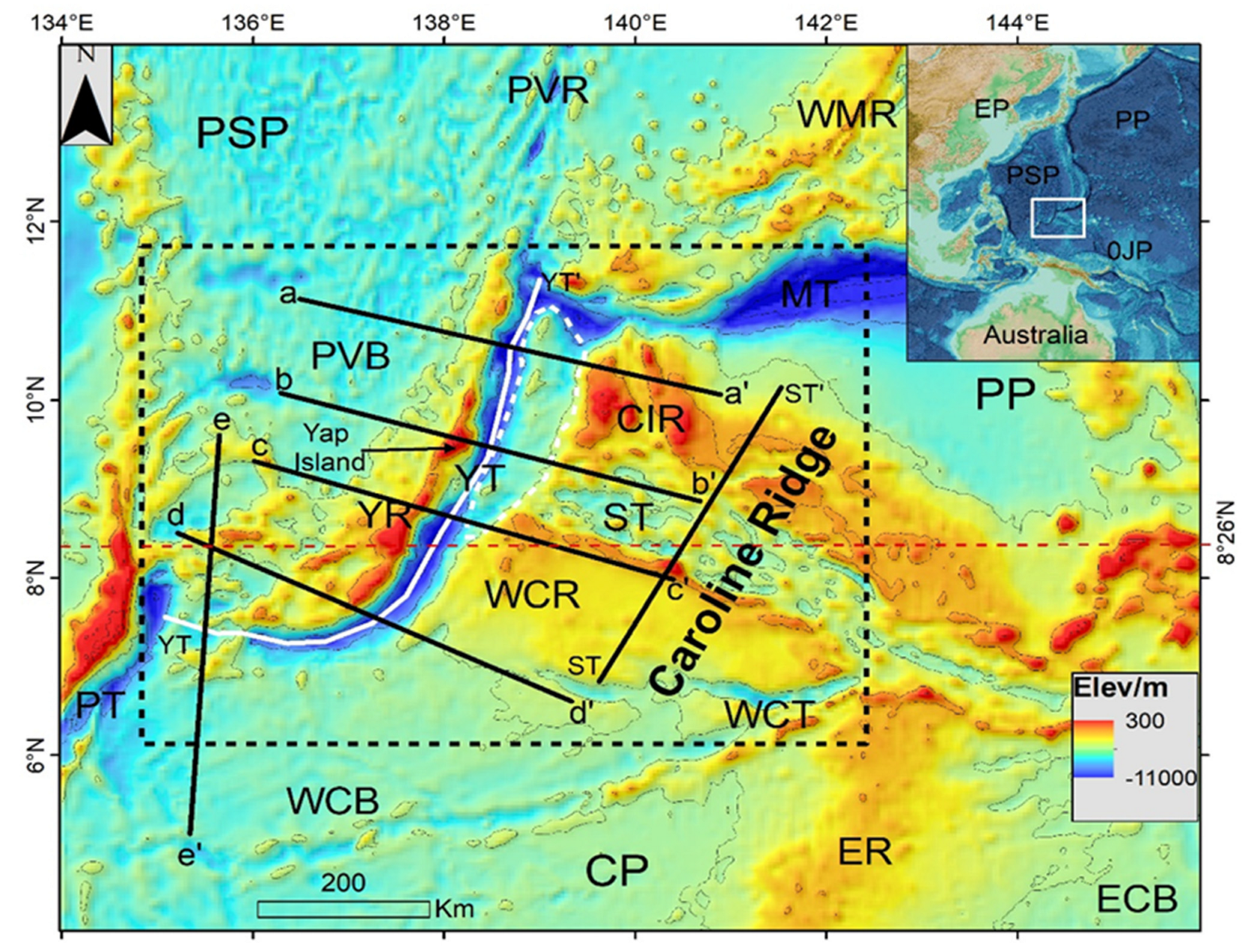
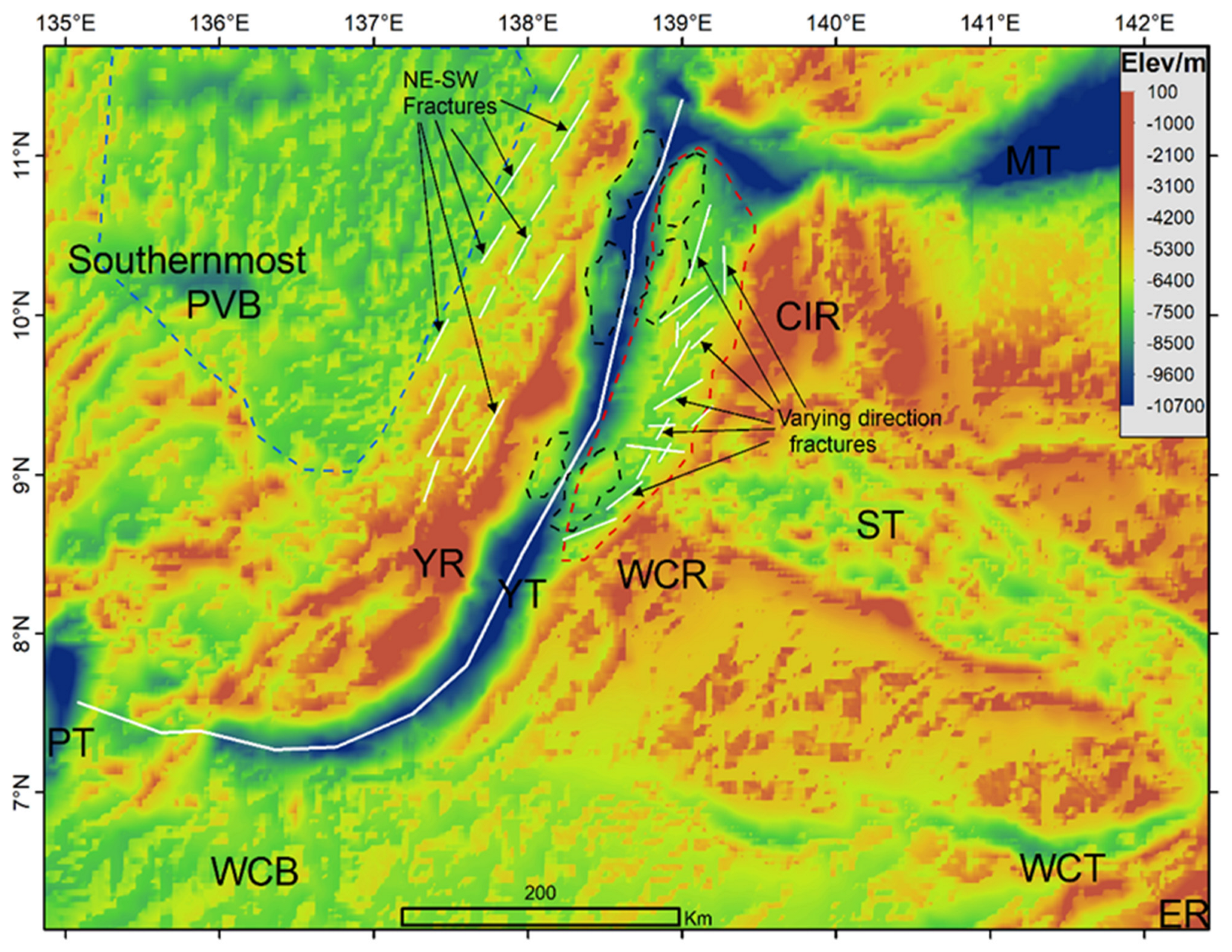


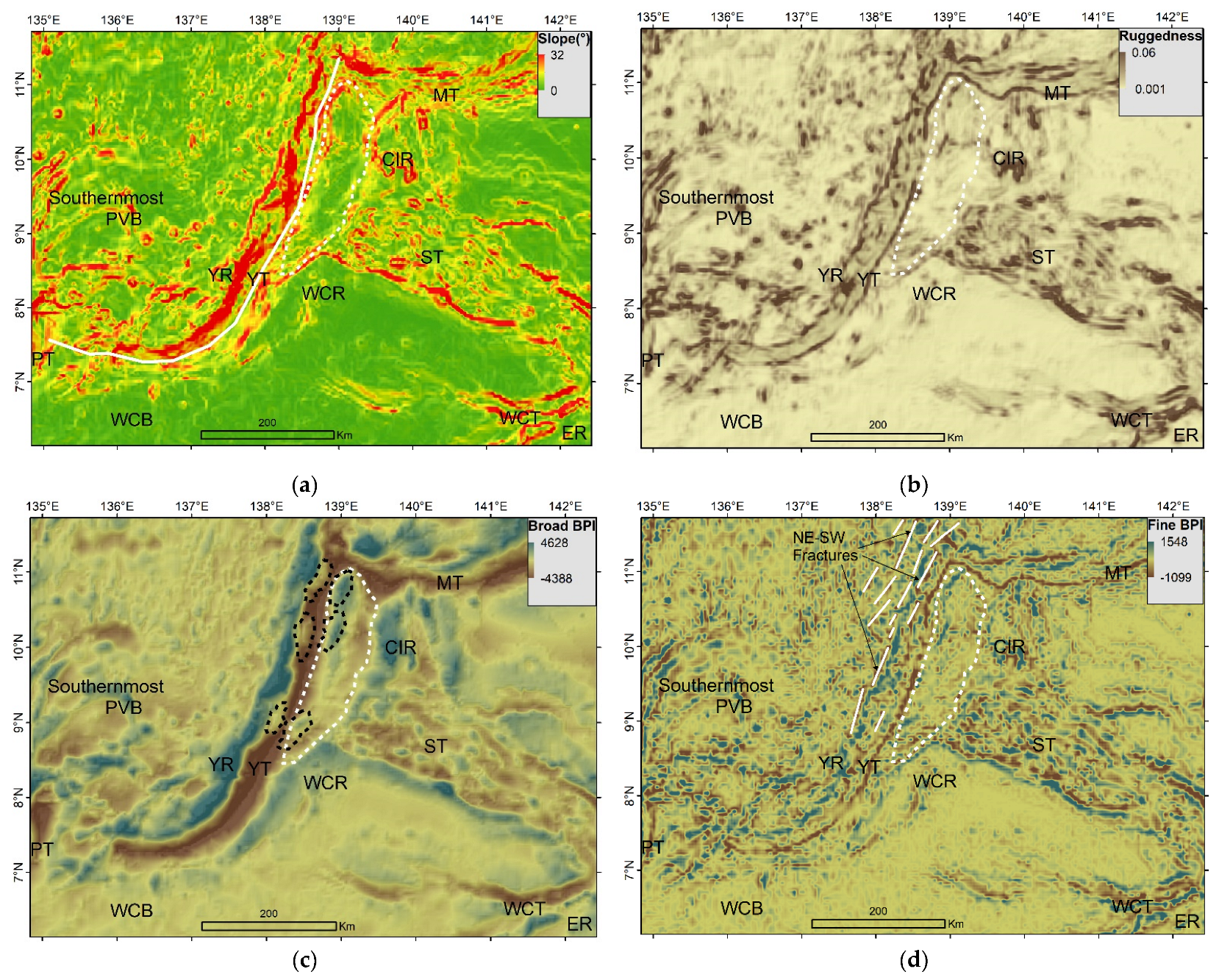

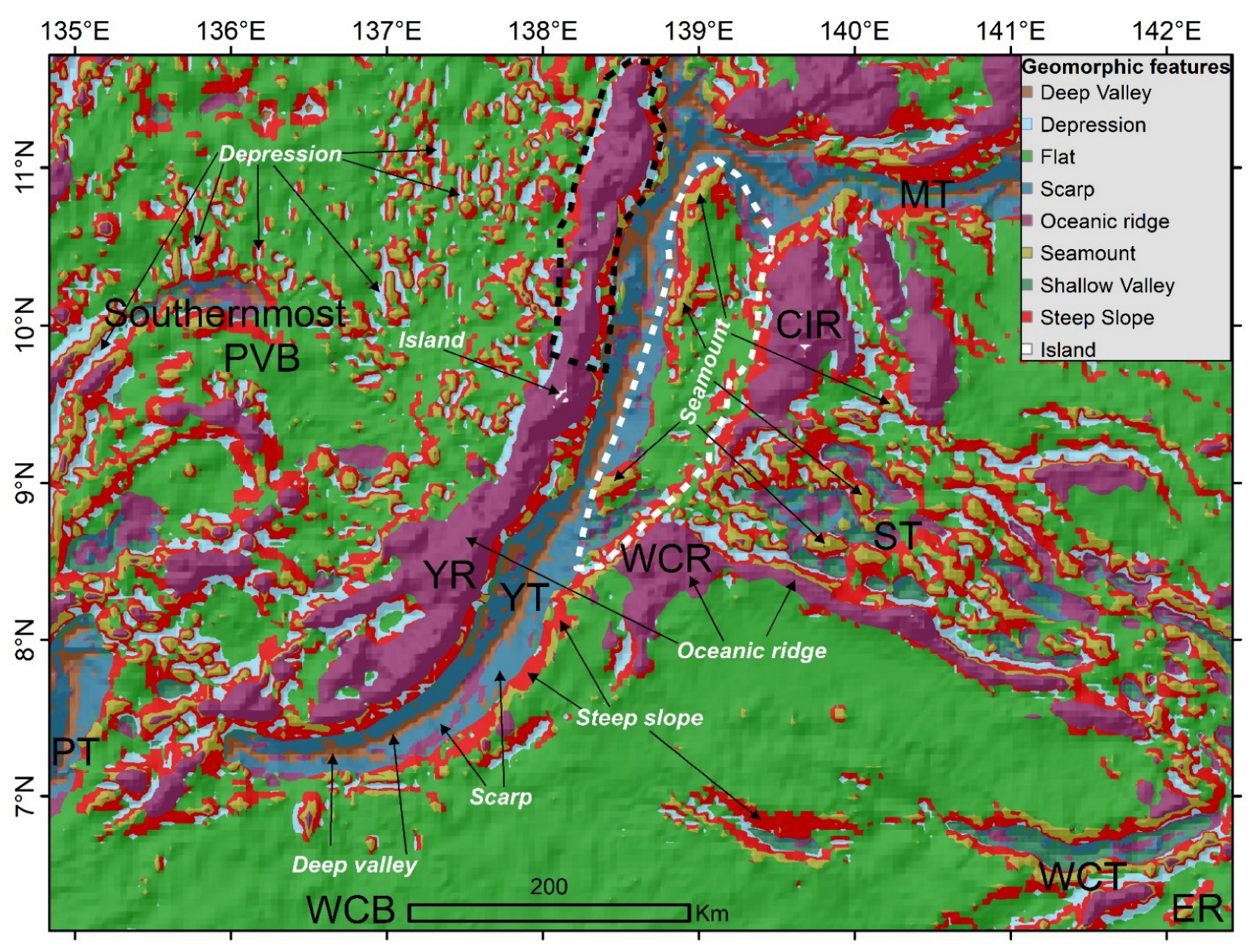
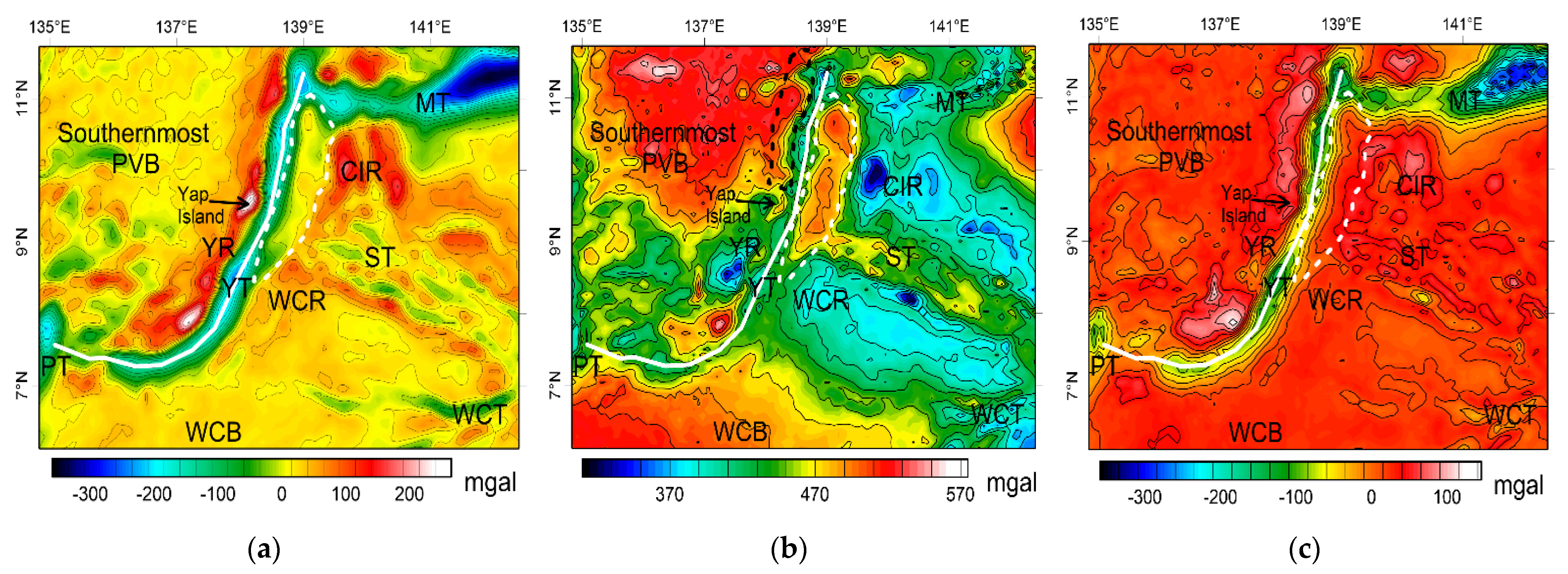

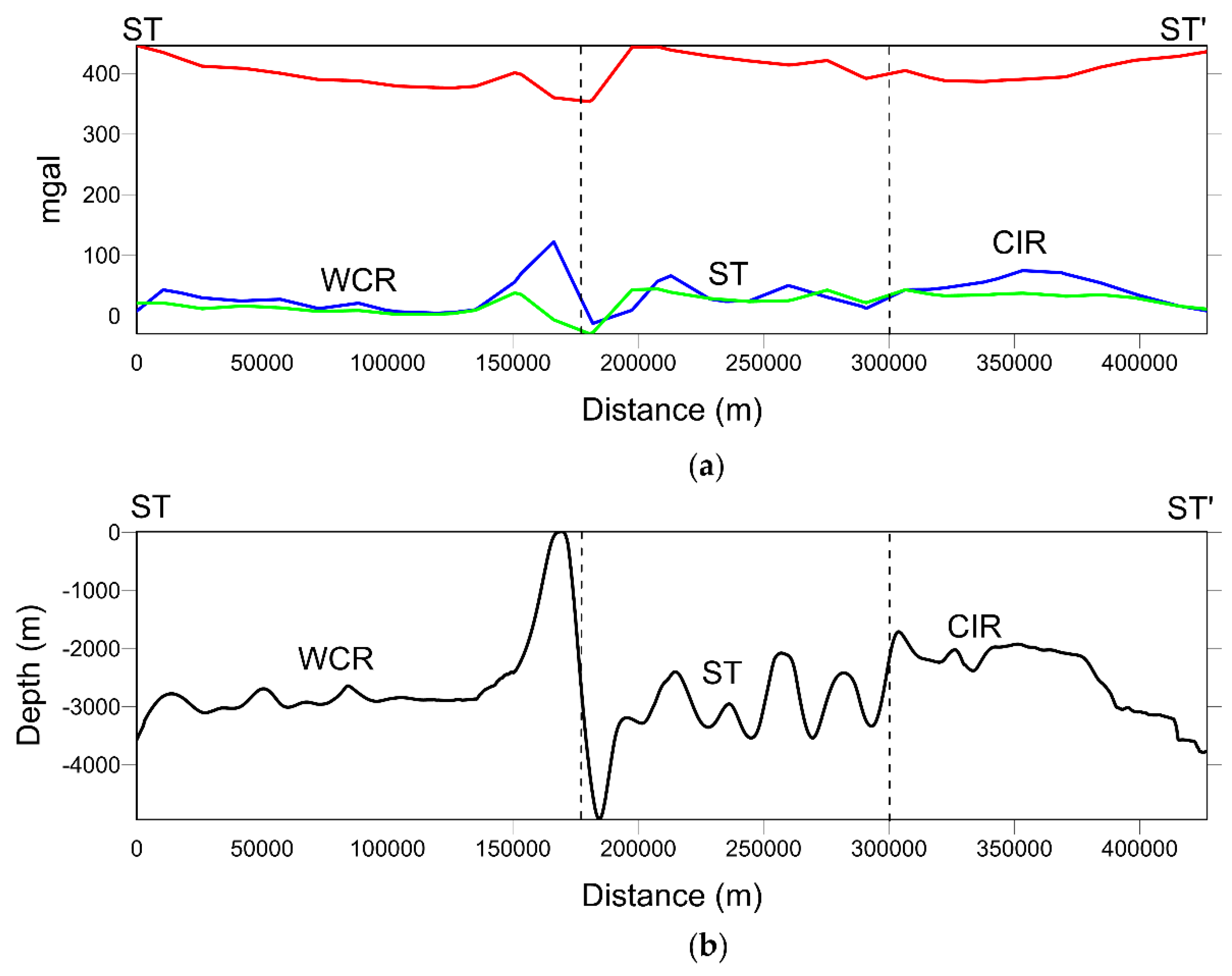
| Terrain Attribute | Parameter | Unit | Tool |
|---|---|---|---|
| Slope | 3 × 3 cell neighborhood | Degree | BTM |
| Broad BPI | 150 and 15 cell radii | Unitless | BTM |
| Fine BPI | 15 and 3 cell radii | Unitless | BTM |
| Ruggedness | 3 × 3 cell neighborhood | Unitless | BTM |
| Feature ID | Seabed Feature | Broad BPI | Fine BPI | Slope | Depth | ||||
|---|---|---|---|---|---|---|---|---|---|
| Lower | Upper | Lower | Upper | Lower | Upper | Lower | Upper | ||
| 01 | Deep valley | −100 | −100 | −5772 | |||||
| 02 | Depression | −100 | 100 | −100 | |||||
| 03 | Flat | −100 | 100 | −100 | 100 | 4 | |||
| 04 | Scarp | −100 | −100 | 100 | 4 | ||||
| 05 | Oceanic ridge | 100 | 100 | 0 | |||||
| 06 | Seamount | −100 | 100 | 100 | |||||
| 07 | Shallow valley | −100 | −100 | −5772 | |||||
| 08 | Steep slope | −100 | 100 | −100 | 100 | 4 | |||
| 09 | Volcanic arc/island | 100 | 100 | 0 | |||||
Publisher’s Note: MDPI stays neutral with regard to jurisdictional claims in published maps and institutional affiliations. |
© 2022 by the authors. Licensee MDPI, Basel, Switzerland. This article is an open access article distributed under the terms and conditions of the Creative Commons Attribution (CC BY) license (https://creativecommons.org/licenses/by/4.0/).
Share and Cite
Sangana, P.; Gao, Q.; Li, Z. The Impact of the Caroline Ridge Subduction on the Geomorphological Characteristics of Major Landforms in the Yap Subduction Zone. J. Mar. Sci. Eng. 2022, 10, 1414. https://doi.org/10.3390/jmse10101414
Sangana P, Gao Q, Li Z. The Impact of the Caroline Ridge Subduction on the Geomorphological Characteristics of Major Landforms in the Yap Subduction Zone. Journal of Marine Science and Engineering. 2022; 10(10):1414. https://doi.org/10.3390/jmse10101414
Chicago/Turabian StyleSangana, Peter, Qin Gao, and Zilong Li. 2022. "The Impact of the Caroline Ridge Subduction on the Geomorphological Characteristics of Major Landforms in the Yap Subduction Zone" Journal of Marine Science and Engineering 10, no. 10: 1414. https://doi.org/10.3390/jmse10101414
APA StyleSangana, P., Gao, Q., & Li, Z. (2022). The Impact of the Caroline Ridge Subduction on the Geomorphological Characteristics of Major Landforms in the Yap Subduction Zone. Journal of Marine Science and Engineering, 10(10), 1414. https://doi.org/10.3390/jmse10101414






